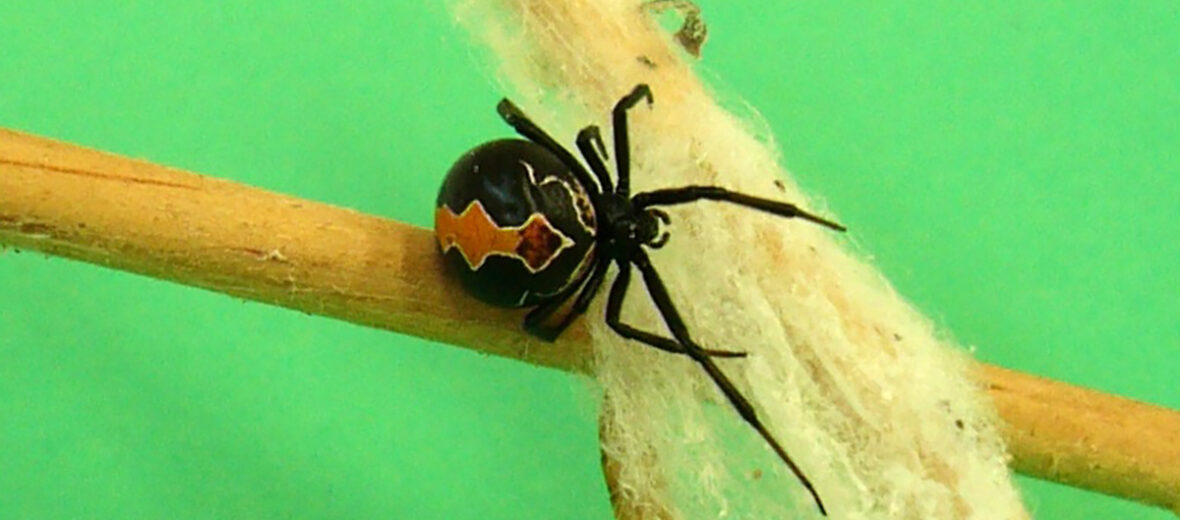
The katipō, aka red katipō, black katipō, and New Zealand’s redback, is a spider species native to New Zealand. These arachnids are in a larger family of spiders known as Latrodectus. Other spiders in this family are the deadly Australian redback spider and the black widow spider, of the United States (for example). These spiders are small with up to a pea sized abdomen. They are ground dwelling spiders are prefer sand dunes close to the seashore. These spiders are not currently listed with the IUCN, but it is thought that they are in decline and considered an Endangered species.
First the Stats…
Scientific name: Latrodectus katipo
Length: Up to .31 inch
Lifespan: Up to 2 years
Now on to the Facts!
1.) Like other Latrodectus species, their webs are kind of haphazardly spun and lack any artistic looking design.
2.) Their primary threats are habitat loss and invasive spider species.
3.) Their bite is medically significant but there is an antivenin produced to counter the effects of a bite. This antivenom is called Red Back Spider Antivenom (CSL) TM.
4.) These spiders are quite notable in New Zealand as the nation is nearly entirely devoid of dangerous native wildlife. So these arachnids really negatively stand out, even though they are seldom ever encountered.
5.) This spider was formally described as Latrodectus katipo by L. Powell in 1870.
But wait, there’s more on the katipō!
6.) Their closest relative is the Australian redback spider.
7.) After mating in August – September, the female produces 5 – 6 egg sacs in November – December, each containing up to 90 fertilized eggs.
Did you know…?
A bite can cause the toxic syndrome latrodectism. This is characterized by extreme pain, muscle regidity, sweats, vomiting, hypertension, seizures, and/or coma. Death is not likely except with young children, elderly, or immune compromised individuals.
8.) Spiderlings, aka slings, hatch during January – February and quickly disperse into nearby cover to avoid being eaten.
9.) Other names for this spider are cobweb spiders, comb-footed spiders, or tangle-web spiders.
10.) Katipō hails from the Māori word meaning “night stinger”.
But wait, there’s still more on the katipō!
11.) Their diet consists of various invertebrates, beetles, amphipods, moths, flies, and even other spiders.
12.) When a prey item becomes entangled in the spider’s web, the spider will approach the prey item, turn around and, using their spinnerets and back legs, they quickly encase their victim in a cocoon of sorts and then bite their victim several times to ensure death.
Did you know…?
It is estimated that there are only a few thousand katipō remaining, to date.
13.) When the spiderlings hatch some utilize ballooning (spinning a single web strand and then floating away on the wind’s currents), while others just use bridging (climbing over the web strands to find a new home).
14.) There has been evidence of interbreeding between katipō and redback spiders in the wild. This has resulted in variants or hybrids.
15.) Their primary natural predator is a yet to be described predatory wasp that has been documented feeding on the katipō’s eggs.
But wait, there’s still a little more on the katipō!
16.) In the 1990s, the South African spider coined the false katipō has been introduced and is slowly displacing the katipō along the west coast of the North Island from Wellington to Whanganui.
17.) In 2010 the katipō was 1 of at least 12 species of previously unprotected invertebrate that was given full protection under the 1953 Wildlife Act, noted as “iconic, vulnerable to harm, and in serious decline”. Under the Act, killing an absolutely-protected species such as the katipō is punishable by a fine and/or imprisonment.
18.) Even though these spiders are medically significant, they rarely bite and instead prefer to roll into a ball and fall to the ground. But, that being said, if molested or threatened enough, they will happily bite.
19.) Females guarding her egg sacs are also rather defensive and will not hesitate to bite to save her offspring.
Now a Short Katipō Video!
Be sure to share & comment below! Also, check out the Critter Science YouTube channel. Videos added regularly!
Want to suggest a critter for me to write about? Let me know here.
Some source material acquired from: Wikipedia & IUCN
Photo credit: Jess Costall




Leave a Reply